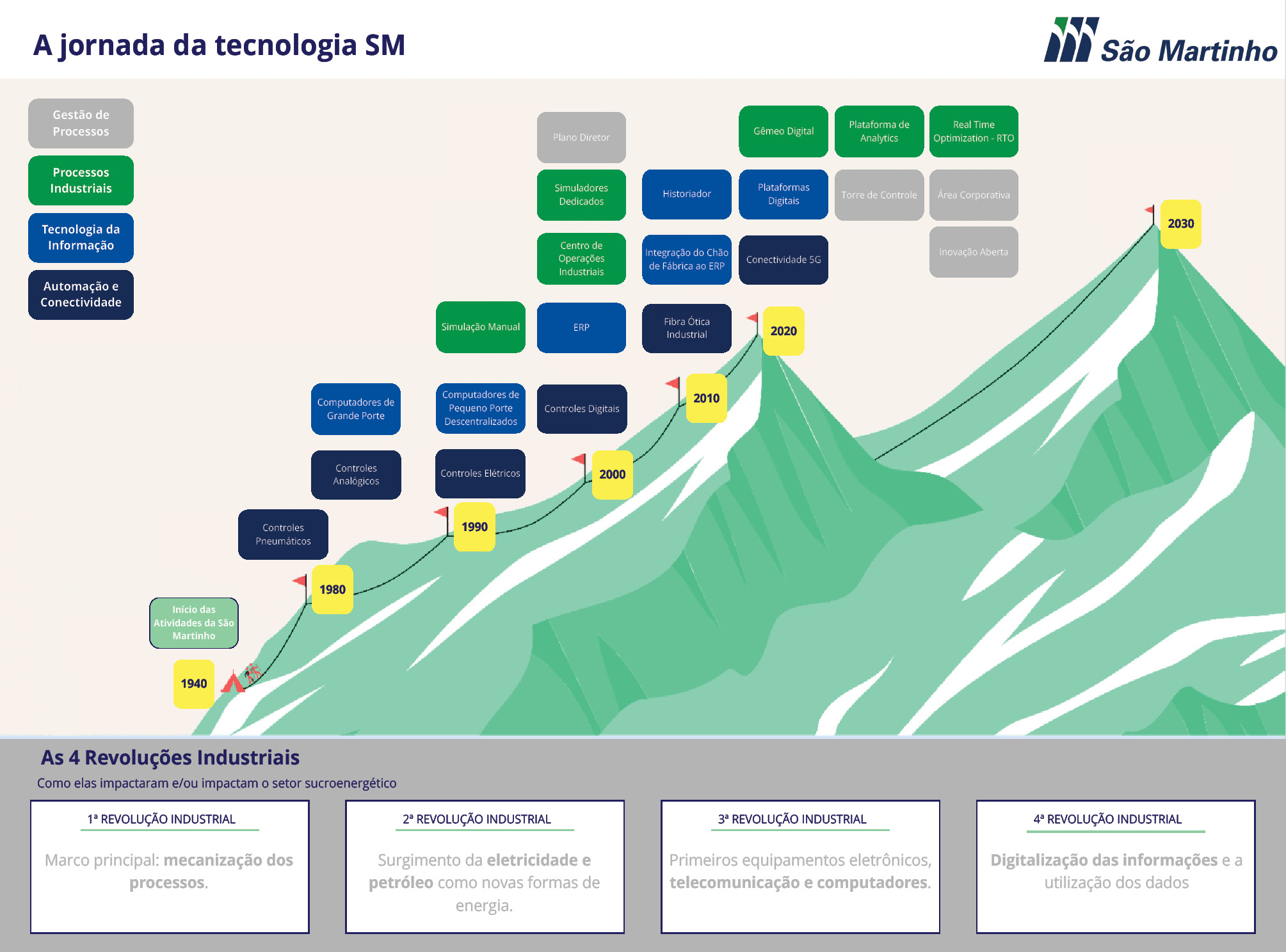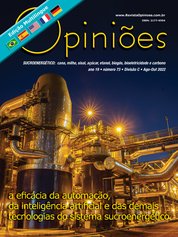Fernando Cullen Sampaio e Guilherme Fraga
Assessor de Tecnologia Industrial e Especialista em Automação da São Martinho, respectivamente
OpAA73
Controles avançados e autonomia no setor sucroenergético
Olhar para as tecnologias como habilitadoras para eficiência, segurança operacional e redução de custos é uma prática que acompanha o setor sucroenergético há muito tempo. Nas primeiras revoluções industriais, era muito claro o papel da tecnologia; as análises de viabilidade, dentro de sua complexidade, estavam limitadas à troca de ativos físicos por ativos mais capazes.
A eficácia dos trabalhos sempre identificada por meio do objetivo atingido se mantém observada, aumentando a eficiência e segurança e reduzindo os custos dos processos. Dentro de tantos caminhos e oportunidades tecnológicas nos dias atuais, essa observação é menos trivial; conhecer bem nossos desafios e encontrar as melhores maneiras de atingir os objetivos operacionais, táticos e estratégicos são pontos-chave da geração de resultados através da tecnologia e fundamentais para a prosperidade do setor.
A eficácia dos trabalhos sempre identificada por meio do objetivo atingido se mantém observada, aumentando a eficiência e segurança e reduzindo os custos dos processos. Dentro de tantos caminhos e oportunidades tecnológicas nos dias atuais, essa observação é menos trivial; conhecer bem nossos desafios e encontrar as melhores maneiras de atingir os objetivos operacionais, táticos e estratégicos são pontos-chave da geração de resultados através da tecnologia e fundamentais para a prosperidade do setor.
Para obtermos abordagens efetivas pela tecnologia, é necessário considerar o contexto histórico e o espectro tecnológico legado que trouxe o setor até os patamares atuais, que começa nas primeiras revoluções industriais, com a substituição da força de trabalho manual e tração animal pelas primeiras turbinas a vapor, seguida pela eletrificação de motores e uso de equipamentos elétricos. Os resultados e impactos dessas mudanças trouxeram não só os ganhos diretos observados durante a mudança, mas permitiram um grande aumento da escala das atividades no setor. Por volta dos anos 1940, período de fundação das nossas primeiras unidades, moíamos em uma safra menos do que o equivalente à moagem de um único dia atualmente.
Com o surgimento da Terceira Revolução Industrial e total domínio da eletricidade, foi possível desenvolver automações de alta complexidade, reproduzindo as melhores operações, conhecidas pelos melhores operadores e em tempo real. Mais uma vez, gerando impactos nunca antes vistos pelos processos, traduzidos em estabilidade, produtividade e menor custo por unidade de moagem.
Hoje, vivemos a Quarta Revolução Industrial, uma revolução silenciosa, quase imperceptível aos menos atentos, mas que dá um grande salto à frente, converge sistemas, transforma dados e informações em conhecimentos novos, permitindo tomada de decisão olhando para o futuro e não mais para o passado.
Em contrapartida, com sua complexidade, profundidade e rapidez com que chega às empresas, com grandes promessas de ganhos, é comum observarmos diversas iniciativas, que se sobrepõem em seu objetivo final durante a busca pelos resultados vislumbrados.
No contexto histórico da São Martinho, desde a instalação dos primeiros processos automáticos provenientes de lógicas pneumáticas, eletropneumáticas e painéis elétricos, já era possível capturar valor dos sistemas, que assumiam as primeiras tarefas repetitivas e relevantes das plantas industriais; seguindo pelos primeiros controladores, possibilitando fechar as primeiras malhas de controle de algumas variáveis para estabilizar processos críticos da planta, gerando maior estabilidade. O sucesso dessas práticas, de forma rápida e natural, viabilizou os primeiros controles digitais que, hoje, desdobram-se por todo o ambiente industrial.
Não só as práticas de controle e automatização surgiram e se aperfeiçoaram, mas também os sistemas de engenharia de processos e gerenciamento da planta. As primeiras iniciativas de simulação dos balanços de massa e energia da planta industrial, em grandes planilhas manuais, permitiram o planejamento da safra e o desdobramento diário para viabilizar a operacionalização.
Essa prática foi responsável por nortear nosso negócio até os anos 1990, e, com sua evolução, o norte encontrado a cada safra ficou cada vez mais claro, possibilitando entender também as melhores rotas e os possíveis desvios a serem feitos. Os impactos eram percebidos em uma geração de valor cada vez mais aderente, melhores estratégias comerciais, demandas de automação e otimização dos ativos agroindustriais.
Assim, evoluções de controle, automação, TI e processos industriais avançaram de tal forma, que tanto as atividades dos processos como a tecnologia convergiram em seu desenvolvimento e, hoje, fazem parte de um mesmo e único roadmap. Como resultado, em minutos, conseguimos obter diversos cenários de produção, baseados nos dados agroindustriais, calculados por um gêmeo digital, que simula os processos em tempo real e vai muito além de um bom planejamento e também inclui o controle da planta de forma autônoma (laço fechado com otimização em tempo real - RTO), com base no melhor cenário global de eficiência possível e com a planta em nossas mãos. Essa visão sistêmica, baseada em engenharia e cálculos complexos, só é possível graças ao poder computacional, à confiabilidade e à segurança dos sistemas integrados, com bases de dados confiáveis, uma infraestrutura robusta e completa de medição e atuação no processo.
A evolução operacional da planta, que atualmente é digital e otimizada, faz parte de uma jornada que começou com a infraestrutura base proveniente das primeiras revoluções industriais e foi potencializada a um patamar anteriormente inimaginável no momento de transição tecnológica.
Com todos esses resultados, fica clara a importância do processo de automação das plantas agroindustriais, não apenas pelos ganhos e resultados, mas para habilitar o uso das tecnologias e também por contribuir para a transição do perfil técnico dos colaboradores, que são ainda mais capacitados para análises de dados, desvios e estatísticas de processos, e não somente operam uma planta de maneira repetitiva, alterando set points constantemente ou abrindo e fechando válvulas sob demanda.
O caminho pela frente ainda é longo e, por vezes, incerto; quando olhamos para trás, percebemos o quanto evoluímos e ainda temos que evoluir com os conhecimentos já adquiridos das revoluções e tecnologias existentes. Novas tecnologias também facilitam, por meio de soluções diferentes, resolvermos problemas antigos, que não se viabilizaram no passado e não chegaram até o estado da arte tecnológico.
Tudo isso com baixo custo de aplicação, alto potencial de retorno e, muitas vezes, sem necessidade de adquirir um único ativo. Esse é o poder do digital, da conectividade, das novas inteligências e tecnologias que evoluem a cada dia e vão nos levar ao amanhã de forma exponencial.
O crescimento exponencial e não linear precisa ser acompanhado de perto. Se a eficácia da automação, inteligência e tecnologias disponíveis no passado eram muito certas e percebidas com análises relacionais, a mudança tecnológica atual é cada vez mais rápida, e seu acompanhamento, avaliação, adoção com base sólida e controle dos riscos são a chave para o sucesso.
No antigo, e ainda atual, mundo VUCA – Volátil, Incerto, Complexo e Ambíguo, que já evolui para o mundo BANI, traduzido em Frágil, Ansioso, Não linear e Incompreensível, surgem novas necessidades para as empresas.
A São Martinho estrutura sua área corporativa, com uma visão estratégica das unidades, baseadas em uma visão global comparativa de cada unidade, em que a estratégia corporativa é desdobrada até o nível operacional e conectada por especialistas, que têm o olhar para as tendências, práticas e principais tecnologias de referência, tornando possível capturá-las e trazê-las para o grupo, de forma a garantir a velocidade adequada, suportados por ecossistemas robustos de inovação e pesquisa, pelos quais conseguimos completar nosso corpo de especialistas empreendedores e pesquisadores de diferentes universidades e startups que estão à nossa disposição, para entender e solucionar nossos desafios, gerando novas inovações e produtos para o ecossistema.





